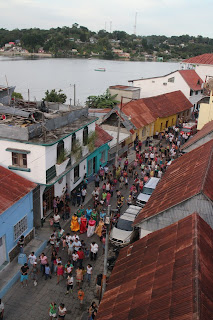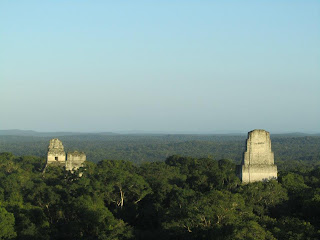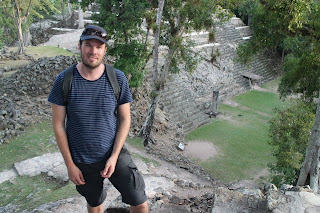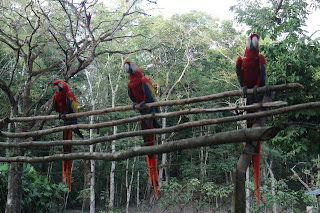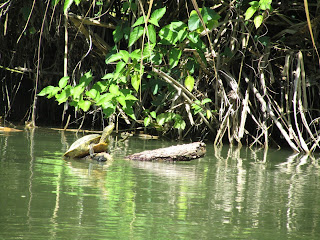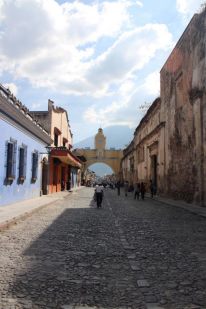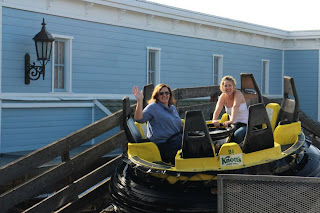
More photos for this post are on Facebook.
The first few weeks in Guatemala seemed to crawl by and we managed to pack in so much into each day – but like all holidays, once you reach the final stretch, time flys by.
The last week of Guatemala involved us travelling the entire length of the country, where we did three 12 hour journeys, crammed into the back of a tiny minibus over four days. We knew our time in Guatemala was coming to an end, and we were anxious not to miss the disappearing river and pristine pools of Semuc Champey and the towering volcanoes and traditional Mayan villages of Lake Atitlan.
Semuc Champey
We left Flores at 7am on Wednesday the 16th of January and travelled south to the city of Coban and then almost doubled back north east to Lanquin, a Qéqchi Mayan town high up in the central cloud forest. We reached Lanquin just after nightfall but still had another hour journey to Semuc Champey, a remote village only accessible by four wheel drive. Sixteen of us tourists were packed into the back of a partly covered truck sitting on planks of wood which slid around perilously at every turn in the road. Despite the long journey, we were all in high spirits and enjoyed the bumpy adventure. At Semuc Champey we were given a room in the ceiling of a straw roofed hut with a foot of a gap all around the eves. A mosquito net kept the bugs at bay and as the electricity generator switched off at 10pm (we only had electricity from 6pm until 10pm), we fell into an exhausted slumber.
The next morning, we began an action packed day of pool diving, exploring caves by candle light and floating lazily down on the Cahabon River on tubes. The Cahabon River at this particular point cuts under a bed of limestone, reappearing 300 meters further down river. Above this natural limestone bridge are a series of stepped turquoise pools of still water. Over 20 pools cascade one after another following the direction of the underground river after which they all merge in an impressive waterfall. We first saw the the river and pools from a viewing point above where you can get a true appreciation of the site before following the forest path down to the water below.

 Despite the overcast day the pools were refreshing without being too cold to properly enjoy them. As one pool flowed into another, the water cut through the limestone creating natural slides of which some were and were not safe to slide down. Our Mayan guide talked us through each slide telling us where to put our arms and which direction to point but that didn´t stop a number of us who bumped and bounced unceremoniously down the slides gaining new bruises as we went. I can adequately describe the beauty of this place and pictures don´t really do it justice. Another traveller we met before visiting Semuc Champey said it was the most beautiful place she had ever seen, and while I have seen some contenders for this title on this trip alone, it is definitely up there. The remoteness of the area, the unspoilt forest and high cliffs flanking either side of the river and the quality of the crystal clear water all contribute to the almost mystical aura of Semuc Champey.
Despite the overcast day the pools were refreshing without being too cold to properly enjoy them. As one pool flowed into another, the water cut through the limestone creating natural slides of which some were and were not safe to slide down. Our Mayan guide talked us through each slide telling us where to put our arms and which direction to point but that didn´t stop a number of us who bumped and bounced unceremoniously down the slides gaining new bruises as we went. I can adequately describe the beauty of this place and pictures don´t really do it justice. Another traveller we met before visiting Semuc Champey said it was the most beautiful place she had ever seen, and while I have seen some contenders for this title on this trip alone, it is definitely up there. The remoteness of the area, the unspoilt forest and high cliffs flanking either side of the river and the quality of the crystal clear water all contribute to the almost mystical aura of Semuc Champey.
 The day ended with tubing down the river. After all the earlier excitement, it was great to just relax. However on the walk back along the river to the accommodation a large black turkey decided the black tube I was carrying had trespassed into his territory and began to charge. I am ashamed to say that I screamed in terror, much to amusement of the local families standing by (and Matt). Thankfully just as the Turkey was getting ready for his second attack, and as I continued with my best rich-white-girl-in-the-countryside scream, a little boy, maybe seven or eight took pity on me a grabbed the turkey by the wing and dragged him back to the hut he shared with the family. While the others found it hilarious, I had memories of when our own gander and terrorised us as children. Thankfully we didn’t have to pass the Turkey again on foot as I don´t think I could of handled a rematch.
The day ended with tubing down the river. After all the earlier excitement, it was great to just relax. However on the walk back along the river to the accommodation a large black turkey decided the black tube I was carrying had trespassed into his territory and began to charge. I am ashamed to say that I screamed in terror, much to amusement of the local families standing by (and Matt). Thankfully just as the Turkey was getting ready for his second attack, and as I continued with my best rich-white-girl-in-the-countryside scream, a little boy, maybe seven or eight took pity on me a grabbed the turkey by the wing and dragged him back to the hut he shared with the family. While the others found it hilarious, I had memories of when our own gander and terrorised us as children. Thankfully we didn’t have to pass the Turkey again on foot as I don´t think I could of handled a rematch.
Lake Atitlan
 The next day we headed back to Lanquin by truck and then on to Coban and Antigua by minibus. Antigua was definitely less intimidating the second time around but we made sure to check out the ATMs before using them to prevent a repeat of the earlier card swiping. The next day after a brief rest we took the bus for Lake Atitlan which on a good day takes four to five hours and on a bad takes a lot longer. That was a bad day and we arrived once again after nightfall. Not ideal when you still have to find accommodation. We stayed in San Pedro but there are many other similar small villages nestled around the lake. Here life for the local people has stayed very much unchanged even with the arrival of tourism. Many of the restaurants, hostels and bars which are owned and run by ex pats are contained to the two streets closest to the lake. In the streets further back life for the local people remains almost untouched. Woman do make extra money from weaving clothes and other souvenirs but other than that the local economy is very insular yet self sustaining. After two days enjoying the relaxed way of life of the region we headed back to Antigua, on to Guatemala Airport and from there flew to Cuba.
The next day we headed back to Lanquin by truck and then on to Coban and Antigua by minibus. Antigua was definitely less intimidating the second time around but we made sure to check out the ATMs before using them to prevent a repeat of the earlier card swiping. The next day after a brief rest we took the bus for Lake Atitlan which on a good day takes four to five hours and on a bad takes a lot longer. That was a bad day and we arrived once again after nightfall. Not ideal when you still have to find accommodation. We stayed in San Pedro but there are many other similar small villages nestled around the lake. Here life for the local people has stayed very much unchanged even with the arrival of tourism. Many of the restaurants, hostels and bars which are owned and run by ex pats are contained to the two streets closest to the lake. In the streets further back life for the local people remains almost untouched. Woman do make extra money from weaving clothes and other souvenirs but other than that the local economy is very insular yet self sustaining. After two days enjoying the relaxed way of life of the region we headed back to Antigua, on to Guatemala Airport and from there flew to Cuba. We really enjoyed Guatemala and all its diversity. Only 60% of the population speak Spanish with the rest speaking one of the 23 Mayan languages which still survive. The Mayan people suffered greatly during the civil war in the 80s where they were accused of harbouring bandits in the mountains. Many remote villages were completely destroyed with large unmarked graves all that was left. The native people, largely uneducated and disconnected from each other due to the language barriers and the remoteness of many of the villages were ill equipped to stand up for themselves and are still regarded as second class citizens. Thankfully this is changing, largely due to tourism as Mayan culture is a major draw card for the country.
For more photos, check out the Facebook album.



